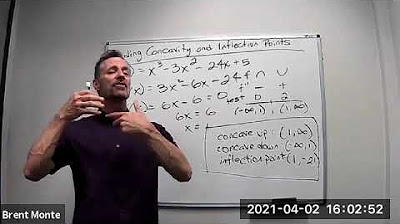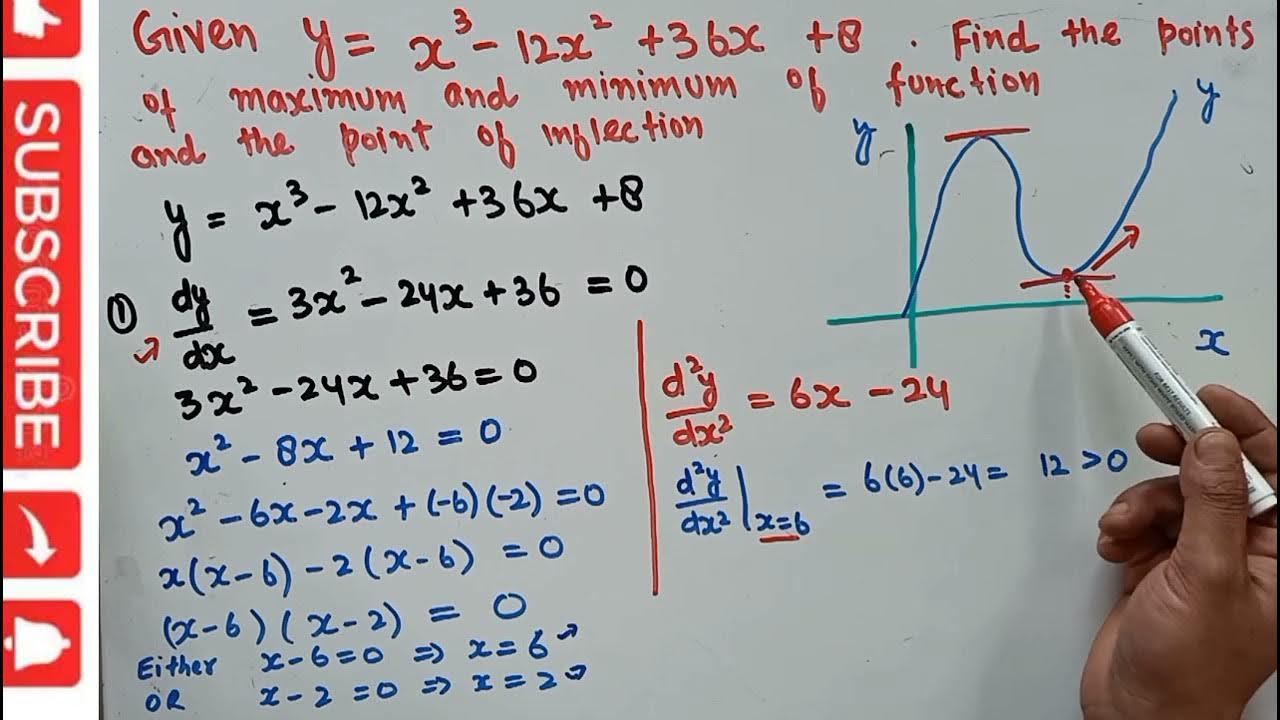Points of inflection from the graphs of f, f' or f''
TLDRThe video script explains three different approaches to identify inflection points of a function. An inflection point occurs where the second derivative changes signs, indicating a change from concave up to down or vice versa. When given the original function, one can visually determine the points where the function's concavity changes. If only the first derivative is provided, one must find where the slope of the tangent line (second derivative) changes signs, which corresponds to the inflection points. Lastly, if the second derivative is given, one directly looks for the points where its value changes signs. The script uses the example of a function with three graphs to illustrate these methods, identifying inflection points at x=3, x=5 for the original function, x=2, x=4, x=6 for the first derivative, and x=1 for the second derivative.
Takeaways
- 📚 Inflection points for a function are where the concavity changes, either from concave up to down or vice versa.
- 📈 To find inflection points from the original function, look for where the function changes from concave up to concave down or the other way around.
- 🔍 When given the original function, visually inspect the graph to identify points where the concavity changes.
- 📉 Inflection points can also be determined by examining the first derivative, which represents the slope of the tangent line to the function.
- 📊 The second derivative indicates the slope of the first derivative's tangent line and helps identify where the slope changes sign.
- 🎯 If given the first derivative, look for points where the slope changes from positive to negative or from negative to positive.
- 📌 When the second derivative is provided, identify points where it crosses the x-axis, as these indicate a change in sign.
- 📐 The second derivative's sign change corresponds to a change in the concavity of the original function.
- 📝 For the given graphs, the inflection points are identified as X equals 3, 5, 2, 4, 6, 1, and another point which is not clearly stated in the transcript.
- 🤓 The method to find inflection points depends on which derivative is given: original function, first derivative, or second derivative.
Q & A
What is an inflection point in the context of a mathematical function?
-An inflection point is a point on the graph of a function where the concavity changes. It is where the function changes from being concave up to concave down or vice versa.
How can you determine the inflection points of a function if you are given the original function f?
-If you are given the original function f, you can determine the inflection points by looking at where the function changes from concave up to concave down or from concave down to up.
What is the significance of the second derivative in finding inflection points?
-The second derivative of a function indicates the rate of change of the first derivative. Inflection points occur where the second derivative changes signs, from positive to negative or from negative to positive.
How does the first derivative help in identifying inflection points when it is given?
-When the first derivative is given, the second derivative can be interpreted as the slope of the tangent line to the first derivative. Inflection points are found where this slope changes sign.
What does it mean for the second derivative to be the slope of the first derivative?
-It means that the second derivative represents how the slope of the first derivative is changing at each point along the function. This change in slope can indicate where the function is changing concavity.
How can you use the second derivative graph to find inflection points?
-You can use the second derivative graph to find inflection points by looking for where the graph crosses the x-axis, indicating a change in sign of the second derivative.
What are the X values of the inflection points in the first scenario described in the script?
-In the first scenario, the X values of the inflection points are X = 3 and X = 5, where the function changes concavity.
In the second scenario, where the first derivative is given, what are the X values of the inflection points?
-In the second scenario, the X values of the inflection points are X = 2, X = 4, and X = 6, where the slope of the first derivative changes sign.
For the third scenario, where the second derivative is given, how do you find the inflection points?
-In the third scenario, you find the inflection points by looking for where the second derivative crosses the x-axis, indicating a change in sign.
What are the X values of the inflection points in the third scenario described in the script?
-In the third scenario, the X values of the inflection points are X = 1 and another value that is not specified in the transcript.
Why does the script mention that an inflection point is not necessarily where the second derivative crosses the x-axis?
-The script mentions this because a crossing of the x-axis indicates a sign change, but an inflection point specifically requires that the second derivative changes from positive to negative or from negative to positive, not just any crossing.
Outlines
📈 Identifying Inflection Points from the Original Function
The paragraph discusses how to determine the inflection points of a function by examining the original function 'f'. It explains that inflection points occur where the function changes concavity, from concave up to down or vice versa. The speaker demonstrates this by looking at the graph of the function and identifying two points where the concavity changes, which are the inflection points at X=3 and X=5.
Mindmap
Keywords
💡Inflection Points
💡Original Function 'f'
💡First Derivative
💡Second Derivative
💡Concavity
💡Sign Change
💡Graphs
💡Tangent Line
💡Slope
💡X-Axis
Highlights
The importance of identifying inflection points in the original function f.
Three different graphs are provided to represent various scenarios for finding inflection points.
Inflection points are where the second derivative changes signs from positive to negative or vice versa.
Explanation of how to find inflection points by observing the shape of the original function f.
Identification of two inflection points at X equals three and five by analyzing the concavity.
Second derivative as the slope of the tangent line to the first derivative.
Finding inflection points by looking for where the slope of the first derivative changes signs.
Three inflection points identified at X equals two, four, and six from the first derivative graph.
When given the second derivative, look for where it crosses the x-axis to find inflection points.
Inflection points occur where the second derivative changes from negative to positive or positive to negative.
Two inflection points identified at X equals one and another undetermined value from the second derivative graph.
The significance of the second derivative in determining the concavity and inflection points.
The method of finding inflection points when given the original function f is straightforward.
The first derivative provides information about the slope and concavity changes.
The second derivative directly indicates where the concavity changes by its sign changes.
Practical steps to identify inflection points from different representations of the function.
The conclusion summarizes the process of finding inflection points using the original function, first, and second derivatives.
Transcripts
Browse More Related Video

Worked example: Inflection points from first derivative | AP Calculus AB | Khan Academy

Point of Inflection - Point of Inflexion - f''(x)=0 - Definition - How to Find - Worked Example 1

Finding Concavity and Inflection Points

Inflection Point Grade 12

How to Find Inflection Points

Maxima , minima and point of inflection
5.0 / 5 (0 votes)
Thanks for rating: